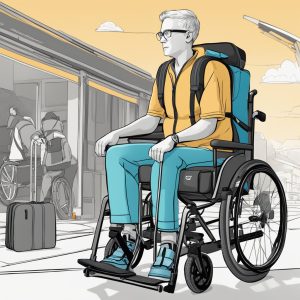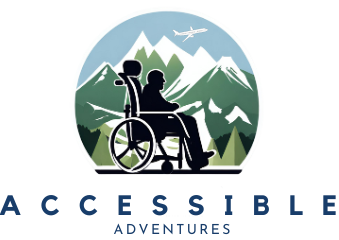Traveling with a Wheelchair: Essential Packing Tips and Must-Have Accessories

Traveling with a wheelchair requires careful planning and strategic packing to ensure a smooth and enjoyable journey. As a wheelchair user or someone traveling with mobility equipment, your checklist will differ from the traditional traveler. Navigating through different terrains, transportation, and accommodating your daily mobility needs calls for specialized gear and a proactive approach to packing.
Securing your wheelchair for travel is paramount, whether you’re heading out on a road trip or flying across the globe. From covering your wheelchair with a padded cover to protect it from damage to ensuring that all detachable parts are safely stored, you’ll want to consider how to best prepare your mobility aid for the journey ahead. Additionally, knowing the ins and outs of airline policies, and how to efficiently pack your luggage without compromising on essentials, can make all the difference.
Accessing suitable accommodation and understanding how to navigate new environments daily is an essential part of travel planning. Researching ahead and asking the right questions can prevent surprises and ensure that your destination is equipped to handle your requirements. By anticipating challenges and knowing how to address them confidently, your travel experience can be as rewarding and stress-free as possible.
Key Takeaways
- Strategic planning and protective measures ensure safe travel for your mobility equipment.
- Knowledge of policies and efficient packing methods is crucial for smooth airline travel.
- Research and inquiries about accessibility can enhance accommodation and daily experiences.
Preparing Your Wheelchair for Travel
When you’re planning a trip, it’s crucial to ensure your wheelchair is ready for the journey. This involves selecting the appropriate chair, ensuring it’s in top condition, and packing necessary accessories to make travel smooth.
Choosing the Right Wheelchair
Depending on your destination, you need to decide whether a power wheelchair or a manual wheelchair is more suitable. If you’re flying or navigating areas where you can’t rely on power outlets, consider a manual wheelchair with a lightweight frame and detachable parts. A freewheel attachment might be beneficial for rough terrains. On the other hand, if you’re traveling by car and will have access to charging facilities, your power wheelchair promises greater independence.
Maintenance and Spare Parts
Before leaving, thoroughly inspect your wheelchair. Look for any signs of wear or damage and perform any necessary repairs. It’s wise to pack a repair kit with essential spare parts like bolts, nuts, and tools, as well as extra detachable parts. Ensure your wheelchair’s battery is fully charged and consider carrying a spare if possible. Regular maintenance checks are key to avoiding unexpected issues during your travels.
Portable Wheelchair Accessories
Always remember to bring portable ramps to combat the unpredictability of accessibility on the road. These portable ramps should be lightweight yet durable, and ensure they fit within your vehicle and are suitable for the kinds of barriers you might encounter. If you’re a power wheelchair user, carry a compatible charger—and verify that it matches the power specifications of your destination. A compact modern wheelchair can facilitate the inclusion of these accessories, making travel easier and more comfortable.
Packing Your Luggage Efficiently
When traveling with a wheelchair, efficient packing is crucial for a hassle-free experience. Select the right luggage, organize your essentials thoughtfully, and keep important items accessible.
Luggage Selection for Accessibility
Opt for luggage that offers a balance between durability and ease of handling. Backpacks with multiple compartments can be hung on your wheelchair for quick access. While a duffel bag provides more space and flexibility, checked luggage with smooth-rolling wheels facilitates easier transport.
Organizing Your Travel Essentials
Make the most of your space by grouping items based on use. Clothing and personal items should be packed in compression bags to save space and reduce clutter. Travel chargers and battery chargers for your devices belong in a dedicated electronics organizer, allowing you to charge on the go without any hassle.
- Electronics
- Travel charger: front pocket
- Battery charger: side compartment
Essential Documents and Emergency Items
Keep your passport, medication, money, and credit cards in a travel wallet or a secure, easily accessible compartment in your travel bag. This ensures you’re prepared for customs, medical needs, and any purchases during your journey.
- Documents and Emergency Items
- Passport and credit cards: travel wallet
- Medications: labeled pill organizer
Carrying these items in a specific location minimizes stress and keeps you focused on enjoying your trip.
Traveling by Air with a Wheelchair
Successfully navigating air travel requires familiarity with security protocols and awareness of your rights. Your comfort and safety during the flight also hinge on proper preparations and knowing how to address in-flight needs.
Airport Security and Boarding Procedures
At airport security, ensure your wheelchair goes through a manual check if it cannot pass through the X-ray machine. Communicate any special considerations necessary due to your mobility device. When boarding the airplane, airlines should prioritize your access, helping with seating and storing your wheelchair in the cabin or as checked luggage, per the Air Carrier Access Act.
- Request pre-boarding to allow sufficient time for seating accommodation.
- Verify that your mobility device is properly tagged and stowed.
In-flight Comfort and Safety
Once on board, aim for in-flight comfort through strategic seat selection and by utilizing available inflight entertainment. Your safety can be enhanced through:
- Making sure flight attendants are aware of your mobility needs.
- Familiarizing yourself with the locations of accessible restrooms.
Do not hesitate to request assistance for any in-flight needs to ensure proper care and comfort throughout your journey.
Navigating Airports and Airplanes
While at the airport, research access services beforehand and remember your rights under the Americans with Disabilities Act. Tools like portable ramps can be crucial when navigating airplanes and airports.
- Use airport assistance services to navigate through terminals.
- Plan for accessibility features in advance to accommodate your air travel needs efficiently.
Accommodation and Daily Mobility
When you travel with a wheelchair, ensuring that your hotel room meets your needs and that you can navigate local transportation are pivotal for a smooth experience. Equally important is optimizing your daily travel gear to maintain independence and ease of movement.
Hotel Accessibility and Room Preparation
Before booking, verify that the hotel room is wheelchair-friendly, with wide doorways and a roll-in shower chair if required. Upon arrival, ensure enough space for your wheelchair or scooter to maneuver and place frequently used items like your camera, smartphone, or laptop within easy reach.
Local Transportation and Navigation
Research transportation options that accommodate wheelchairs, such as accessible rental vehicles or transit services. Apps and maps detailing wheelchair-accessible routes can simplify getting to and from restaurants and attractions. Carry a photo or written description of your wheelchair if it gets misplaced.
Daily Travel Gear and Tips
Pack a collapsible commode, extra batteries for your scooter, and a portable USB charger for your smartphone and camera to capture memories. When packing your carry-on, include essentials like medications and a repair kit for unexpected wheelchair mishaps, enabling caregivers and disabled travelers alike to focus on the journey.
Frequently Asked Questions
Navigating travel with a wheelchair comes with unique challenges. The following FAQs address common concerns, ensuring your journey is as smooth as possible.
How can I securely attach luggage to my wheelchair?
Utilize Velcro straps and bungee cords to fasten bags securely to your wheelchair frame. This prevents shifting and maintains stability during movement.
What are the most durable luggage options for wheelchair users?
Look for luggage made from high-denier fabric and feature reinforced stitching. These materials offer enhanced durability for the wear and tear associated with travel.
What should I pack when traveling with a wheelchair internationally?
Pack essential wheelchair repair kits and any necessary custom equipment. This includes spare parts, tools, and especially items like extra catheters if applicable.
How do I prepare my wheelchair for air travel to ensure its safety?
Inform the airline in advance and remove any loose components. Protect your wheelchair by wrapping frame parts with padding and bubble wrap.
What specialized equipment should I consider when traveling with a wheelchair?
Depending on your destination, a portable ramp or a travel-specific shower chair might be necessary. Consider the local terrain and accommodation facilities when deciding what specialized equipment to bring along.
What are the best practices for packing a foldable wheelchair in a travel bag?
Ensure that the wheelchair is folded properly and secured tightly in the bag. Choose a bag that fits the chair snugly to avoid unwanted movement and reduce the risk of damage.
